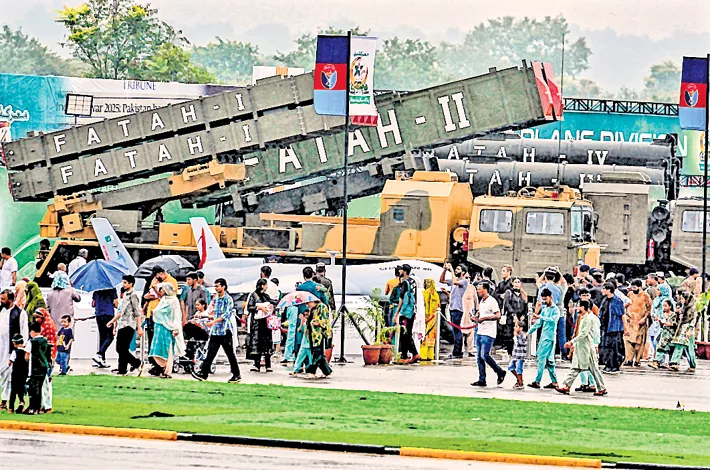Gainers and losers in the 100-hour India-Pak conflict
31-05-2025 12:00:00 AM

India’s failure to neither confirm nor deny the loss of its top-end fighter jets only served to reinforce Pakistan’s mistaken sense of victory
What does the common Indian feel regarding the cessation of this swift 100-hour military conflict between India and Pakistan where both sides are claiming victory? There are some obvious victors. This four-day conflict has seen Prime Minister Modi emerge much stronger, assisted ably by the hyper-nationalistic narrative being pummelled by his government. In Pakistan, his principal antagonist, Pakistan’s army chief, General Asim Munir, has had himself promoted to the rank of a Field Marshal, having emerged stronger and more popular after this crisis.
Burnishing his nationalist credentials will definitely help swing the mood in Modi’s favour in the coming state elections, and the recent road show held in Ahmedabad and the BJP-led Tiranga yatras held post the cessation of fighting will go a long way in keeping this fervour alive. Munir’s promotion, on the other hand, signals a further consolidation of military power in Pakistan.
Further consolidation of power in the hands of two ultra-nationalist leaders does not bode well for the future of the subcontinent. For one, Modi’s statement that any future terrorist attack will be met with an `Operation Sindhoor-like response’, will serve to create an atmosphere of permanent instability in the two countries, which is bound to have serious consequences, especially on the economic front.
Asim Munir is a radical Islamist and does not hide his views on how, for Pakistanis, Kashmir remains the `jugular vein’, which must be wrested at any cost. Even if he had not been the army chief, Pakistan has been trying to win over Kashmir for the last 75 years. Its army has trained and sponsored terrorism there for the last 35 years.
The Indian army is well aware of this symbiosis between the Pakistani state and terrorists, and how difficult it is to control it. Will the bombing of terrorist headquarters in Pakistan and PoK deal a crippling blow to them? Very unlikely, as they have not lost any of their top-level leaders. Successive governments in the past have dealt with this problem, albeit in a covert manner.
This four-day fighting has brought another key factor that can no longer be underestimated. India is no longer fighting Pakistan alone. China has put its weight solidly behind Pakistan by providing it with the latest military equipment along with logistical and satellite support.
It has also, albeit behind the scenes, used its diplomatic muscle to ensure that few countries came out in our support. India’s neighbours receive a huge amount of aid from China, and not one of these was willing to rub the Red Dragon the wrong way. Even our oldest ally, Russia, did not publicly express support for us, suggesting a degree of cautious neutrality given that they too have entered into a strategic and economic partnership with China.
It was the attack on Pakistan’s Nur Khan base by Indian forces which saw warning bells ring across the international community as it was considered an equivalent to crossing the Rubicon. Pakistan is reported to have warned the US that they would not hesitate to use their Nasr and Shaheen missiles, both of which are nuclear tipped. This could result in a catastrophic nuclear chain reaction from both sides. By then the Americans and Saudis had exerted enough pressure to get Pakistan’s director general of military operations, Major General Kashif Abdullah, to speak to his Indian counterpart.
Will this US intervention ensure that this is no longer a bilateral issue, thereby handing over a strategic advantage to Pakistan, which has been wanting to internationalise the Kashmir issue? This is not a good signal, given our lack of international support and the heft China enjoys as a member of the UN Security Council.
India has stated that it will focus only on terrorism and Pakistan-controlled Kashmir in any future talks with Pakistan. But today we also have to deal with Chinese-occupied Kashmir. Under such a complex scenario, it is important for India to start informal dialogues with Pakistan held in a third-party country as an immediate step to return to regional stability.
The cessation of war had barely been announced when it became obvious that both sides were on a major arms-buying spree. Pakistan is already in talks with China for another 40 fifth-generation fighters, which are going to be delivered shortly. Pakistani pilots have already been sent to China for advanced training. While the Chinese claim they are selling these to Pakistan at half the price, defence experts believe most of this equipment is likely to be supplied free of cost for other benefits.
India is going to need to update its equipment and is already shortlisting which fighter planes to purchase at an enormous cost to the exchequer.
An analysis by the UAE-based Foreign Affairs Forum has calculated that India’s military expenditure during the first three days of the assault (May 7-9) is estimated to have ranged between Rs 1,460 crore and Rs 5,000 crore per day.
These costs include the deployment of BrahMos missiles, priced at $2.5 million to $5.6 million each, and kamikaze drones at $500 per unit, while the cost of high-tech drones worked out to around $350,000 per target. The FAF estimated Pakistan’s military costs for a conventional war at around $11.8 million to $83.2 million.
The problem is that while India wants to keep up its economic momentum, Pakistan depends on bailouts and is confident the Chinese and the US will come to its aid whenever required.
While there is no doubt that India is the aggrieved party, Pakistan claims it has won the war. India’s failure to neither confirm nor deny the loss of its top-end fighter jets only served to reinforce their mistaken sense of victory. The real victor in this war has been China. For a country that has not theoretically fought a war since 1979, it has had its weapons tested without firing a shot.
While their J 10 C fighter jets and JF 17 Thunder fighters proved effective, their HQ 9 defence system and PL 15 missiles proved to be ineffective against the Indian firepower. India was being projected as a counterweight to China, but given their economic and diplomatic clout, we have a lot of catching up to do.








